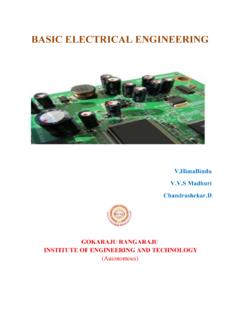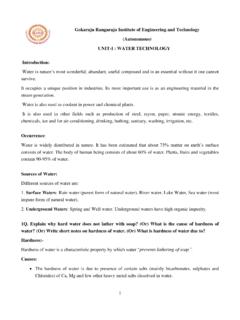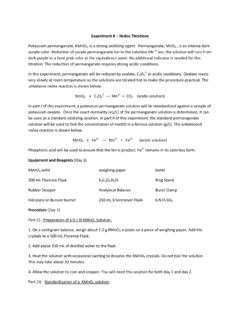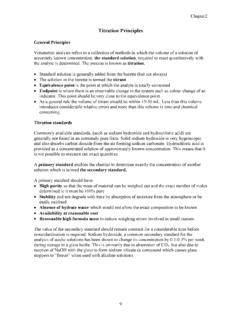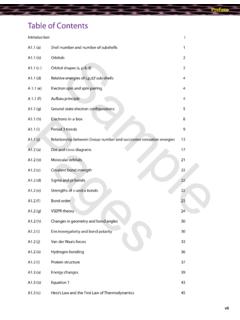Transcription of UNIT II - ELECTROCHEMISTRY & CORROSION - GRIET
1 1 unit II - ELECTROCHEMISTRY & CORROSION ELECTROCHEMISTRY is a branch of chemistry which deals with interconversion of electrical energy to chemical energy and vice versa. For ex: i) In a battery, chemical energy is converted to electrical energy ii) In electroplating / electrolysis electrical energy is converted to chemical energy Electric current is a flow of electrons. Substances that allow electric current to pass through them are known as conductors. For ex: the metals, graphite, fused salts, aqueous solution of acids, bases & salts. While insulator or non-conductor is a substance which does not allow electric current to pass through it. For ex: wood, plastic; Q1) What are conductors? How are they classified? Differentiate metallic conductors from electrolytic conductors. Conductors are of two types: Metallic conductors: These are substances which conduct electricity by electrons.
2 For eg: all metals, graphite etc; Na, K, alkaline earth metals Cu, Ag, Au and other transition metals. Electrolytic conductors: Are the substances which in aqueous solution (or) in fused state liberate ions & conduct electricity through these ions, there by resulting in chemical decomposition: For eg: Acids, bases & salt solution. etc. Conductance: Reciprocal of resistance is called conductance. C = 1/R. For metallic conductors, resistance is the characteristic property. Whereas electrolytes are characterized by conductance rather than by resistance. The resistance of a conductor [metallic] is directly proportional to its length & inversely proportional to its cross sectional area[ ohm s law] R = Resistance in ohms 2 ; R = lA = specific resistance l = Length in cm. A = area of cross section in cm2 Thus, when l = 1cm & A = 1cm2 then R = Thus, the specific resistance is defined as the resistance of a 1 centimeter cube.
3 Q2) Define following terms and explain their relationship. a) Specific conductance, b) Equivalent conductance and c) Molar conductance. Specific conductivity: ( ) is the reciprocal of specific resistance of an electrolytic solution. , = l = lAR Hence specific conductivity is the conductance of 1cm3 of a solution. Units: = 1AR = cm 2 = cm-1 -1 (or) ohm-1 cm-1 (or) Scm-1 Where, Ohm-1 = S Equivalent conductivity: [ eq] is the conductance of all the ions liberated by 1 gram equivalent of the electrolyte at v dilution. If 1gm equivalent of electrolyte is present in v ml, then eq = v Specific conductivity = v (volume v contains of 1gram equivalent of electrolyte) Otherwise, if the normality of electrolytic solution is N then v = 1N L (N = concentration) = 1000N ml = 1000N cm3 .: eq = 1000N Units : eq = v = cm3 ohm-1 cm -1 eq -1 = ohm-1 cm 2 eq -1 ( or ) S cm2 eq-1 3 Molar conductivity: ( m) is defined as the conductance of all the ions produced by 1 mole of an electrolyte at v dilution.
4 Suppose 1 mole of electrolyte is present in v ml of solution, then m = v (where v contains 1 mole of the electrolyte) Whereas M is molar concentration in mol l -1 Then m = 1000M Units: ohm-1 cm 2 mol -1 (or) S cm2 mol-1 . Q3. What are conductometric titrations. Explain the conductometric titration of strong acid vs strong base. Conductometric titration- (strong acid vs strong base): Conductometric titration is the volumetric analysis based upon the measurement of the conductance during the course of titration. The number of free ions and mobility of the ions affects the conductance of an aqueous solution. When one electrolyte is added to another electrolyte, the change in number of free ions causes a change in the conductance. For eg: when a strong acid (HCl) is titrated against a strong base(NaOH), before NaOH solution is added from the burette, the acid solution has high conductivity due to highly mobile H+ ions.
5 When NaOH is added to the acid, the conductivity of the acid solution decreases due to the neutralization of highly mobile H+ ions of the acid with OH ions of the base. H+ Cl + Na+ OH Na+ Cl + H2O Thus the conductance of the solution continues to decrease until the equilibrium point is reached. Further addition of NaOH solution will increase the conductance by highly mobile hydroxyl (OH ) ions. The point of intersection of the graph plotted between conductance of the solution on y-axis and volume of alkali added on x-axis corresponds to the end point of titration. Measurement of the conductivity of the solution: Pipette out 40 ml of the HCl solution into a 100ml beaker. Dip the conductivity cell in HCl solution after rinsing the conductivity cell with distilled water and HCl solution.
6 Connect the conductivity cell to the conductometer. Set the function switch to check position. Display must read 1000, if not set it to 1000 with control knob at the back panel. Put the function switch to cell constant position and set the value of cell constant as determined previously. Set the temperature control knob to the actual temperature of the solution. Set the function switch to conductivity position and read the conductivity. This is the exact conductivity of the solution. Add 1 ml 4 of NaOH ( ) solution taken in the burette to HCl solution and stir well. Note the conductivity of the solution after the addition of NaOH solution. Repeat the procedure by addition of 1 ml NaOH ( ) solution every time and noting the conductivity readings of the resulting solution. Take 15 20 readings and note the readings in the given table.
7 Then the following graph will be obtained. The point where it coincides with X-axis corresponds to equivalence point or called as end point.. Q6. Explain the conductometric titration of weak acid vs strong base. Conductometric titration of weak acid vs strong base: CH3 COOH + NaOH CH3 COO- Na+ +H2O Acetic acid has low conductivity (being weak acid), when NaOH is added poorly conducting acid is converted into highly ionized salt, CH3 COONa. As a result by doing the similar titration like above the following graph will be obtained. The conductivity increases very slowly upon addition of NaOH. When the acid get neutralized further addition of NaOH causes a sharp rise in conductance. The intersection point gives the end point. 5 is meant by electrochemical cell. Explain the functioning of Daniel cell?
8 Electrochemical cell: The devices used for converting chemical energy to electrical energy & electrical energy into chemical energy are known as electrochemical cells they contain two electrodes in contact with an electrolyte, they are mainly of two types. 1) Galvanic cells, 2) Electrolytic cells. 1) Galvanic cells: It is an electrochemical cell in which the free energy of chemical reaction is converted into electrical energy electricity is produced from a spontaneous chemical reaction. 2) Electrolytic cell: It is an electrochemical cell in which external electrical energy is used to carry out a non- spontaneous chemical reaction. Daniel cell o It is an example of galvanic cell. o It consists of Zn rod and Cu rod; Zn rod and Cu rod dipped in ZnSO4 solution and CuSO4 solution respectively. o Each electrode in its electrolytic solution is known as half-cell.
9 O The two solutions are connected by a salt bridge, and thus two electrolytic solutions are in contact with each other, in order to complete the circuit. Cell reactions: The electrode reactions of Daniel Cell are : At anode: Zn Zn+2 + 2e- (oxidation) At cathode: Cu+2 + 2e- Cu(s) (reduction) Total cell reaction: Zn + Cu+2 Zn+2 + Cu. 6 Cell representation: An electrochemical cell or galvanic cell is obtained by coupling two half cells. For example, Daniel cell obtained by coupling Zn half-cell and copper half-cell through a salt bridge Zn | ZnSO4 (aq) || CuSO4(aq) | Cu (-ve electrode) ( +ve electrode ) Oxidation takes place Reduction takes place Cell is generally written with the negative electrode on the left hand side and the positive electrode on the right side [ | ] single line represents phase separation [ || ] double lines represents salt bridge When reduction potentials of electrodes are known then the emf of the cell is represented as E = E0 - R TnF log c E = E0 - log c E cell = E right - E left E cell = EMF of the cell.
10 E right = Reduction potential of right electrode. +ve value of Ecell indicates, the cell reactions feasible -ve value of Ecell indicates, that the cell reaction is not feasible. In such case electrodes are to be reversed in order to bring about the chemical reaction. Q7. What are electrolytic cells. Write the difference between electrochemical cells and electrolytic cells. Electrolytic Cells: Those cells which convert electrical energy to chemical energy. Eg: Electrolysis of fused NaCl & aq NaCl. Description: They contain two inert electrodes like Pt. These two are dipped in fused NaCl electrolyte. The two electrodes are connected to an energy source like battery. The electrode which is connected to negative terminal of the battery is cathode and the electrode which is connected to positive terminal of battery is anode. (or) The 7 electrode towards which Na+ ions start moving towards is called as cathode and Cl- ions start moving towards is called the anode.
